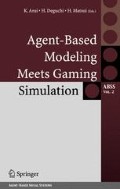Conclusions
We established a multiagent simulation model related to CT that can reproduce an emergent process within a bidding community consisting of several firms. A series of numerical experiments shows that CT does develop, but indicates that there may be different content depending upon the input information provided. In particular, we should recognize the difference between functional CT and intensive CT.
This study was carried out due to the authors’ anxiety regarding the health of the Japanese construction industry and the creation of a better society for the future. Several effective strategies are presented for breaking CT in the real world.
Access this chapter
Tax calculation will be finalised at checkout
Purchases are for personal use only
Preview
Unable to display preview. Download preview PDF.
References
Tanimoto J, Fujii H (2003) A mathematical model for the collusive tendering-studies on the human-environment-society system based on the complexity theory (in Japanese). J Archit Plann Environ Eng 565:379–386
Mcmillan J (1992) Games, strategies and managers. Oxford University Press
Layton-Brown K, Shoham Y, Tennenholtz M (2000) Bidding clubs: institutionalized collusion in auction. Proceedings of ACM Conference on Electronic Commerce (EC’00) 253–259
Hosoe M, Sato H, Imaizumi H, et al. (1997) Economics of public policy (in Japanese). Yuhikaku
Onozaki T, Yanagita T (2002) Monopoly, oligopoly and the invisible hand. Discussion Paper Series No. 32. Institute of Economic Research, Chuo University
Axelrod R (2000) The evolution of cooperation (in Japanese). Minerva
Matsubara N (2000) Quantitative method of social sciences (in Japanese). University of Tokyo Press, Tokyo
Shimazaki T (1996) Analysis of “Dangou” by game theory (in Japanese). Proceedings of Construction Management Research 4:21–28
Hauser MD (1996) The evolution of communication. MIT
Author information
Authors and Affiliations
Editor information
Editors and Affiliations
Rights and permissions
Copyright information
© 2005 Springer-Verlag Tokyo
About this chapter
Cite this chapter
Tanimoto, J., Fujii, H. (2005). A Model for Collusive Tendering Based on a Multiagent Approach. In: Arai, K., Deguchi, H., Matsui, H. (eds) Agent-Based Modeling Meets Gaming Simulation. Agent-Based Social Systems, vol 2. Springer, Tokyo. https://doi.org/10.1007/4-431-29427-9_10
Download citation
DOI: https://doi.org/10.1007/4-431-29427-9_10
Published:
Publisher Name: Springer, Tokyo
Print ISBN: 978-4-431-29426-9
Online ISBN: 978-4-431-29427-6
eBook Packages: Humanities, Social Sciences and LawSocial Sciences (R0)

